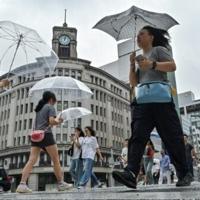A typhoon of significant strength hit Japan’s Pacific coast on Friday, bringing strong winds and heavy rain. This led to the cancellation of numerous flights and trains in the Tokyo area, leaving over 2,000 homes without power.
Located approximately 170 km south of Tokyo, Typhoon Ampil had wind gusts reaching up to 216 km per hour as it moved northeast, according to the Japan Meteorological Agency.
The eye of the typhoon was projected to avoid making landfall, instead moving northeast along the Honshu coast and passing near the Tokyo region, home to around 40 million people, before moving back out to the Pacific on Saturday.
The JMA categorized the weather system as “very strong”, just below the highest classification of a “violent typhoon”, with maximum wind speeds reaching 195 km per hour.
The agency issued warnings for potential violent storms, tidal waves, landslides, floods, and river floods, urging people to be on high alert. The risk of disasters related to heavy rains was expected to increase through Friday night in the Kanto area and into Saturday morning in the northern Tohoku region.
The US military’s Joint Typhoon Warning Center forecasted sustained wind speeds of up to 195 km per hour by early Saturday morning off the coastal Chiba region east of Tokyo.
In Chiba prefecture, over 18,000 people were advised to evacuate due to the typhoon. Additionally, around 2,000 households in Tokyo’s neighboring prefectures, particularly Chiba, were without power on Friday afternoon.
– Flights Cancelled –
All Nippon Airways canceled 335 domestic and international flights on Friday, affecting around 72,000 passengers. Japan Airlines also scrapped 361 flights, impacting 57,000 customers.
Major parts of Japan’s bullet train network, including the busy Tokyo to Nagoya section, were scheduled to close on Friday. Tokyo Disneyland announced its closure from 3:00 pm.
The typhoon coincided with Japan’s “obon” holiday week, when many people return to their hometowns, and came shortly after Tropical Storm Maria caused record rainfall in parts of northern Japan.
Isamu Teruya, 47, a visitor from Saga Prefecture, shared his plans amidst the typhoon, stating, “We will check our phones for any information online and venture outside if the typhoon seems manageable. If the rain is heavy, we will stay in our hotel and relax.”
Recent studies suggest that typhoons in the region are forming closer to coastlines, intensifying more rapidly, and lasting longer over land due to climate change. Researchers analyzed a significant number of historic and future storms to reach these conclusions.
nf-cg-kh/mca





